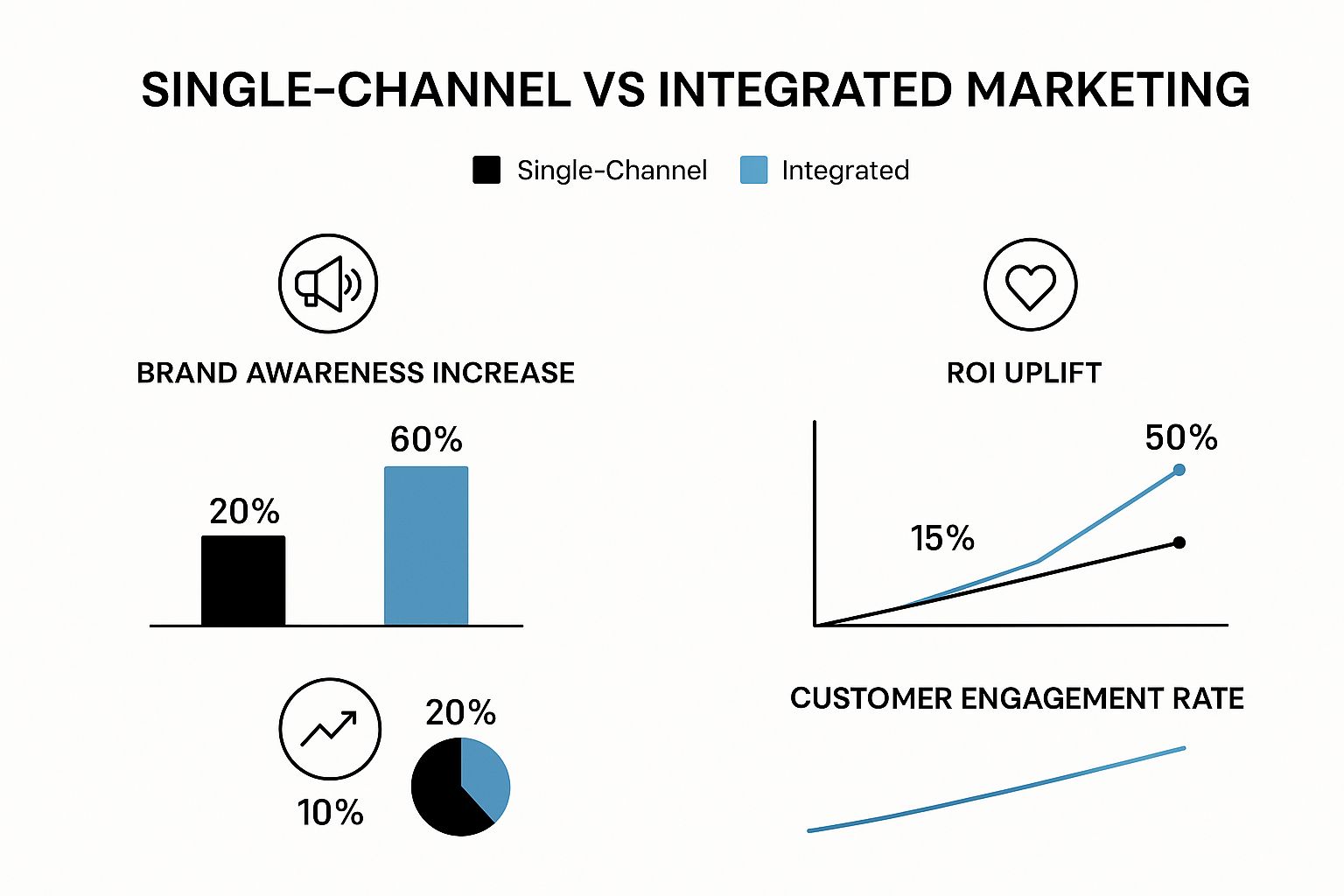The Power of Integration: Transforming Fragmented Marketing

Today’s marketing landscape presents a complex challenge: customers interact with brands across numerous touchpoints. This makes a cohesive and consistent brand experience paramount. This is where the power of an integrated marketing strategy comes into play. It’s about unifying your approach, moving beyond isolated tactics, and creating a resonant experience for your audience throughout their journey.
Understanding the Core of Integration
An integrated marketing strategy aligns all your marketing channels for seamless collaboration. This ensures consistent messaging, branding, and customer experience across every platform, whether it’s social media, email, your website, or traditional advertising. Imagine an orchestra: individual instruments contribute unique sounds, yet harmonize to create a symphony. Similarly, each marketing channel plays a role in a unified brand narrative.
Why Integrated Marketing Matters
Fragmented marketing, where channels operate independently, often leads to customer confusion and wasted resources. Imagine encountering a product promotion on Instagram, but finding a completely different message on the company’s website. This disconnect can erode trust and impact your bottom line.
An integrated strategy, however, can drastically improve campaign performance. Integrating marketing teams and channels can increase campaign efficiency by a significant 31%. This boost comes from coordinating channels like social media, email, and advertising to project a cohesive brand image and message. Learn more about improving campaign efficiency here. This synergy maximizes your return on investment (ROI).
Benefits of an Integrated Approach
An integrated marketing strategy offers several key advantages:
- Enhanced Brand Consistency: Consistent branding across all channels builds stronger recognition and fosters customer loyalty.
- Improved Customer Journey: Guide customers seamlessly through the sales funnel with coordinated messaging at every touchpoint.
- Increased Efficiency and ROI: Streamlined campaigns and reduced redundancies optimize resource allocation and boost ROI.
- Better Data Insights: Connecting data from various channels provides a more comprehensive view of customer behavior and preferences.
From Silos to Synergy: Moving Towards Integration
Implementing an integrated marketing strategy requires a shift in mindset and a commitment to collaboration. Breaking down departmental silos is key, fostering a culture of shared goals and open communication. Every marketing team member needs to understand the overall brand strategy and their individual contributions. Through collaboration, you can create a cohesive and impactful marketing experience that resonates with your target audience.
Building Your Integration Blueprint: From Silos to Synergy

Moving from scattered marketing efforts to a cohesive integrated marketing strategy takes planning and a structured approach. It’s about designing a blueprint for synergy. This means assessing your current marketing activities, finding key integration opportunities, and establishing a robust framework to execute your plan. For further insights, explore resources on integrated marketing, such as this: How to master integrated marketing.
Assessing Your Current Marketing Landscape
The first step in building an effective integrated marketing strategy is understanding your current situation. This requires honestly evaluating how fragmented your existing marketing efforts are. Where are the departmental silos? Which teams are working in isolation? This assessment should include all your marketing activities, from content creation and social media management to email marketing and paid advertising.
Identifying High-Impact Integration Opportunities
Once you understand your current marketing landscape, you can identify areas where integration will have the biggest impact. These opportunities should align with your overarching business goals. For instance, if you aim to increase brand awareness, you might prioritize integrating your social media and public relations activities.
Crafting Unifying Brand Narratives
A consistent brand narrative is essential for successful integrated marketing. This narrative connects all your marketing channels. It should be flexible enough to resonate across different platforms while maintaining a strong, core message. This means your brand voice, tone, and visual identity should remain consistent, regardless of the channel.
Governance and Execution: Breaking Down Silos
A clear governance model ensures consistent execution of your integrated marketing strategy. This model defines roles and responsibilities and avoids bureaucratic bottlenecks. Fostering collaboration and communication is crucial for breaking down departmental silos that hinder integration.
To understand the differences between siloed and integrated approaches, let’s look at a comparison table:
This table, “Integrated vs. Siloed Marketing Approaches,” highlights the key differences between traditional siloed marketing and truly integrated strategies.
| Business Aspect | Siloed Approach | Integrated Approach | Business Impact |
|---|---|---|---|
| Campaign Planning | Separate departmental plans | Unified plan across all channels | Increased efficiency and consistency |
| Data Management | Data stored in separate systems | Centralized data management | Improved data analysis and insights |
| Customer Experience | Fragmented customer journey | Seamless customer experience across all touchpoints | Increased customer satisfaction and loyalty |
| Budget Allocation | Separate budgets for each department | Consolidated budget for all marketing activities | Optimized budget allocation and ROI |
| Measurement and Reporting | Individual metrics for each channel | Unified reporting framework | Clearer understanding of marketing effectiveness |
Key takeaways from this comparison include the improved efficiency, data analysis, and customer experience offered by integrated marketing. Centralized data and unified reporting provide a clearer view of overall marketing performance.
Visualizing Integration Success: Charting the Course
The following data chart visualizes the potential improvements an integrated marketing strategy can bring across various key performance indicators (KPIs). This visualization shows how a unified approach significantly impacts results compared to operating in silos.

As the chart demonstrates, an integrated approach can increase brand awareness by 80%, double customer engagement, and more than double lead generation. Conversion rates also see a significant boost, rising by 140%. Customer Lifetime Value sees a smaller percentage increase of 50%, but this still represents a substantial impact on long-term revenue. This data underscores the potential of integrated marketing to not just acquire new customers, but also to nurture lasting relationships. Understanding these potential benefits helps businesses build a strong case for integrated marketing and allocate resources strategically.
Channel Orchestration: The Art of Marketing Synchronization

Creating a seamless customer experience is crucial for any successful marketing strategy. Think of it like conducting an orchestra: each instrument (marketing channel) plays a unique role, yet they must harmonize for the desired effect. This careful coordination is the essence of channel orchestration within an integrated marketing strategy.
Determining the Optimal Channel Mix
Understanding your audience is the first step in effective channel orchestration. Successful brands analyze audience behavior to identify which channels resonate most. This data-driven approach is more effective than relying on assumptions. For instance, if your target audience primarily engages on Instagram and email, concentrating your integrated marketing strategy on these platforms will yield better results than investing in print advertising.
Timing Strategies for Cross-Channel Impact
After identifying your key channels, consider the timing and sequencing of your messaging. A simultaneous rollout across all channels can amplify your message and generate immediate buzz. However, a sequential approach, where messages build upon each other across different channels, can be more effective for complex products or services. This guides the customer through a carefully planned journey. Customer journey mapping is vital for determining optimal sequencing and timing.
Maintaining Message Consistency Across Platforms
A consistent core message is essential for strong brand identity. This doesn’t mean identical content on every platform; instead, adapt content to each channel’s strengths while maintaining the core message. A concise message on Twitter could expand into a detailed blog post and further into a YouTube video, all while adhering to the same core themes within your integrated marketing strategy. This allows for tailored messaging while maintaining consistent brand values.
Creating Cross-Channel Momentum
Each touchpoint should reinforce the others, creating cross-channel momentum that drives engagement and conversions. Imagine a customer seeing a product on Facebook, receiving a personalized email with a discount, and then finding a positive review on a trusted blog. This orchestrated approach builds trust and encourages action, ultimately increasing conversion likelihood.
Examples of Successful Channel Orchestration
Many brands have successfully implemented channel orchestration within their integrated marketing strategies:
- Dove’s Real Beauty Campaign: Dove used TV, print, social media, and public relations to promote body positivity. The core message of self-acceptance resonated across all channels, creating a lasting impact.
- GoPro’s User-Generated Content: GoPro encourages users to share experiences on social media. This content is then amplified across other channels, including their website and advertising, creating a vibrant community and driving sales.
These examples demonstrate the power of channel orchestration within a broader integrated marketing strategy. By coordinating messaging, timing, and content across multiple touchpoints, brands deliver cohesive experiences that resonate with audiences and achieve marketing goals. Through well-executed channel orchestration, businesses can cultivate stronger customer relationships and drive significant business growth.
The Data Backbone: Unifying Your Marketing Intelligence
Data fragmentation presents a significant challenge to truly integrated marketing. Many organizations find it difficult to connect their various data sources. This prevents them from gaining a complete understanding of their customers, limiting the effectiveness of personalization and targeting. However, leading organizations are implementing strategies to overcome these data silos and unlock the potential of their marketing intelligence. This involves building a robust data backbone that connects all marketing touchpoints.
Centralizing Your Customer Data: A Single Source of Truth
A key component of a strong data backbone is a centralized customer data platform (CDP). A CDP serves as a single source of truth, collecting and unifying customer data from all available channels. This includes website interactions, social media engagement, email responses, CRM data, and even offline interactions.
Imagine a customer browsing products on your website, then interacting with a social media ad, and finally making a purchase in-store. A CDP connects these interactions, creating a comprehensive view of the customer journey. This unified view allows for more relevant messaging and personalized offers, strengthening customer relationships and driving sales.
Unlocking Powerful Targeting Opportunities
Integrated data unlocks powerful targeting opportunities that would otherwise be missed with siloed systems. By understanding customer behavior across multiple channels, marketers can identify valuable patterns and trends that inform targeting strategies. This translates to delivering the right message to the right customer at the right time, maximizing the impact of every campaign. The success of these integrated strategies depends heavily on personalized, authentic brand communications. Learn more about building trust through authenticity here.
Accurate Attribution: Understanding the Customer Journey
Another crucial element of a strong data backbone is accurate attribution. An integrated marketing strategy requires a deep understanding of how different touchpoints contribute to conversions. An effective tracking system can accurately attribute results across multiple channels, providing insights into complex customer journeys. These journeys often involve numerous micro-interactions that influence the final purchase decision. This allows marketers to optimize spending and focus on the channels and tactics that deliver the best ROI. Check out our guide on mastering data integration for a more in-depth look.
Building Your Data Integration Framework: Key Considerations
Implementing a robust data backbone involves careful planning and execution. The following are some key considerations:
- Data Quality: Ensuring data accuracy and consistency is paramount. Implement data cleansing and validation processes.
- Data Security and Privacy: Protecting customer data is essential. Adhere to data privacy regulations and implement strong security protocols.
- Integration with Existing Systems: Seamlessly integrate your CDP with current marketing technologies, such as your CRM and marketing automation platforms.
- Scalability: Select a CDP that can handle growing data volumes as your business expands.
To better illustrate the essential data points for effective integrated marketing, consider the following table:
Understanding the key data categories, metrics, challenges, and strategic value is crucial for effective cross-channel marketing.
Essential Data Points for Integrated Marketing
This table outlines the critical data categories organizations should collect and integrate to power effective cross-channel marketing strategies.
| Data Category | Key Metrics | Integration Challenges | Strategic Value |
|---|---|---|---|
| Website Analytics | Page views, bounce rate, conversion rate, time on site | Connecting website data with other marketing channels | Understanding website user behavior and optimizing website performance |
| Social Media Engagement | Likes, shares, comments, follower growth | Tracking social media interactions across different platforms | Measuring brand awareness and identifying influencers |
| Email Marketing | Open rates, click-through rates, conversion rates | Integrating email data with customer relationship management (CRM) systems | Nurturing leads and driving conversions through targeted email campaigns |
| Customer Relationship Management (CRM) | Customer demographics, purchase history, interaction history | Maintaining data accuracy and consistency across different CRM systems | Personalizing customer interactions and building stronger customer relationships |
| Offline Interactions | In-store purchases, event attendance | Integrating offline data with online data sources | Gaining a holistic view of the customer journey and attributing offline conversions to online marketing efforts |
By addressing these considerations and focusing on data quality, security, integration, and scalability, businesses can construct a solid foundation for their integrated marketing initiatives. This foundation facilitates personalized experiences that resonate with customers, strengthening relationships and driving growth.
Brand Consistency: The Integration Cornerstone

Maintaining a consistent brand presence across multiple channels is essential for any integrated marketing strategy. This can present a challenge, even for seasoned marketing professionals. Learning from successful brands offers valuable insights into creating a framework for cohesive brand guidelines that allow for channel-specific tailoring. This consistency strengthens brand recognition and fosters trust with your target audience.
Developing Comprehensive Brand Guidelines
Brand guidelines form the bedrock of a consistent brand experience. These guidelines should cover every facet of your brand, from visual identity (logo, color palette, typography) to messaging tone and value propositions. Consider your brand guidelines as a comprehensive guide ensuring everyone on your team operates from the same principles. For example, a company might use a friendly, approachable tone on social media platforms like Twitter while maintaining a professional tone for email correspondence. Both approaches can align with the overall brand personality while adapting to the specific communication channel.
Streamlining Content Production for Consistency
Efficient content production workflows are essential for maintaining brand consistency without compromising creativity. This involves implementing clear procedures for content creation, approval, and distribution. These procedures ensure alignment with established brand guidelines, irrespective of the channel or content format. They also enable teams to adapt content for different platforms while retaining the core message. This might involve crafting shorter, visually-driven content for Instagram, while producing longer, more detailed articles for your company website.
Maintaining Consistency Across Touchpoints
Customers interact with your brand through various touchpoints, both online and offline. Consistent experiences across every interaction, from website design to customer service, are crucial. This means ensuring that your brand’s visual identity, messaging, and values are consistently represented, regardless of where the customer encounters your brand. For more detailed guidance, explore resources like How to Master Brand Consistency. This reinforces brand recognition and builds trust over time.
Tools and Technologies for Brand Consistency
Various tools and technologies can support marketing teams in upholding brand standards, particularly when teams are geographically dispersed or specialize in different areas. Digital asset management (DAM) systems, for instance, offer a central repository for brand assets such as logos, images, and style guides. This ensures everyone accesses the most current, approved versions. This prevents the use of outdated materials and contributes to a unified brand image. Similarly, brand management software can streamline workflow processes, monitor brand performance across channels, and provide valuable analytics on brand consistency.
The Business Impact of Brand Consistency
A consistent brand experience has a significant impact on business performance. According to Lucidpress, consistent brand presentation increases revenue by 23%. This revenue growth stems from the trust and recognition fostered by consistent branding. It also improves customer loyalty, as customers favor brands they recognize and trust. Moreover, brand consistency simplifies marketing efforts, making a unified brand message easier to communicate across different channels. This allows for more efficient use of marketing resources and ultimately yields a higher return on investment. Prioritizing brand consistency enables businesses to cultivate a strong brand identity that resonates with customers and fuels business growth.
Measuring What Matters: Integration Success Metrics
Traditional, channel-focused metrics often fall short of capturing the true impact of an integrated marketing strategy. Simply measuring website clicks or social media likes won’t reveal the synergistic effects of your cross-channel efforts. This section explores advanced measurement frameworks that provide a more complete picture of your integrated marketing strategy’s effectiveness.
Beyond Siloed Performance Indicators
Moving beyond isolated channel metrics requires a shift in perspective. Instead of focusing solely on individual channel performance, analyze how channels influence each other and contribute to overall business goals.
For example, a social media campaign might not generate many direct sales. However, it could significantly increase brand awareness, leading to higher conversions through other channels like organic search or email marketing. This emphasizes the need for holistic measurement, considering the interplay of all marketing activities.
Implementing Cross-Channel Attribution Models
Understanding the customer journey is crucial for accurate measurement. Attribution models assign credit to different touchpoints based on their influence on the final conversion.
A multi-touch attribution model recognizes that multiple channels often contribute to a single sale. This model assigns weighted credit to each touchpoint. This provides a clearer understanding of each channel’s contribution to the overall success of your integrated marketing strategy. It avoids oversimplification and provides more nuanced insights into channel effectiveness.
Visualizing Integrated Performance with Dashboards
Effective data visualization is crucial for communicating performance to stakeholders. Dashboards that combine data from all marketing channels offer a unified view of your integrated marketing strategy’s success, allowing for quick identification of areas for improvement.
These dashboards should present overall results and provide channel-specific insights. This allows for tactical adjustments within each channel while maintaining focus on the overarching strategy. This balance empowers marketing teams to optimize both the big picture and the individual components of their integrated campaigns.
Post-Campaign Analysis: Identifying Strengths and Weaknesses
Thorough post-campaign analysis is essential for continuous improvement. After each campaign, evaluate the performance of your integrated marketing strategy as a whole, identifying areas of strength and weakness.
- Did certain channels perform better than expected?
- Were there any gaps in the customer journey?
- Did the channels synergize effectively?
These insights inform future campaigns, enabling data-driven refinements that lead to progressively better results.
Examples of Integrated Marketing Measurement
Several organizations demonstrate mature measurement practices within their integrated marketing strategies:
- Company A: Uses a multi-touch attribution model to accurately track customer journeys across multiple channels. This helps allocate marketing budget effectively.
- Company B: Employs a centralized dashboard that visualizes the performance of their integrated marketing efforts. This enables stakeholders to quickly grasp overall performance and identify areas for improvement.
These examples illustrate how a focus on integrated marketing measurement, beyond individual channel metrics, leads to a more comprehensive understanding of campaign effectiveness and allows for continuous optimization.
Ready to take your marketing to the next level? ReachLabs.ai offers a full-service approach to integrated marketing, helping you connect with your audience across all channels. Visit ReachLabs.ai to learn more.





